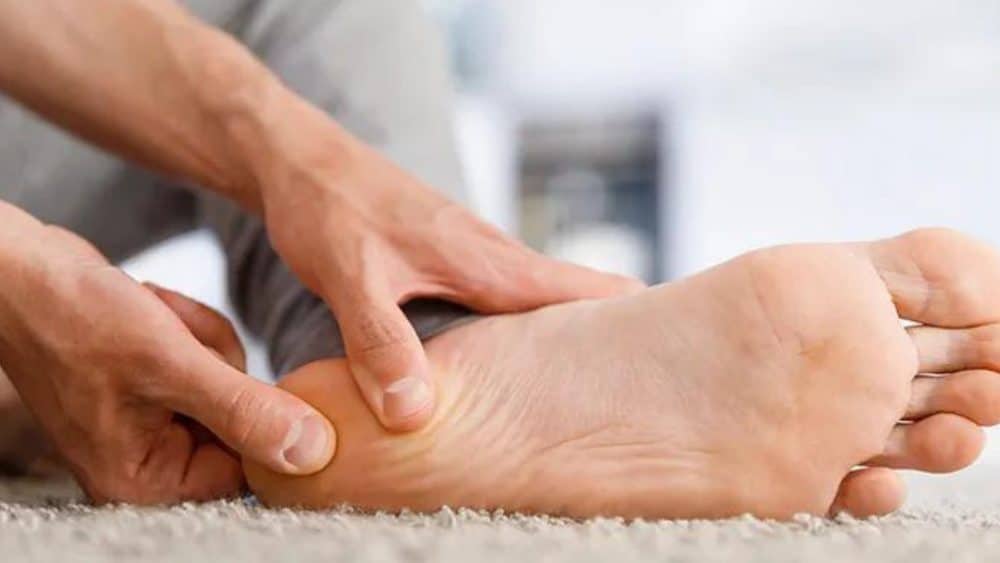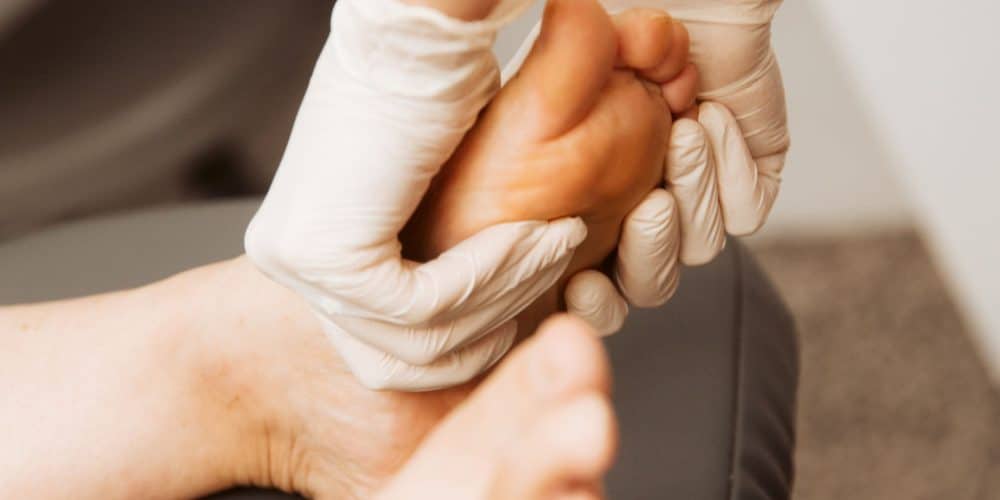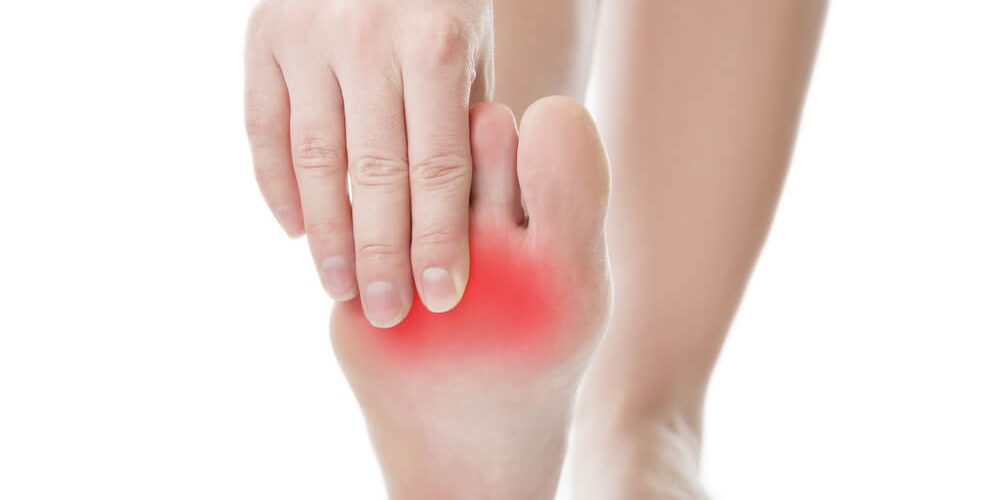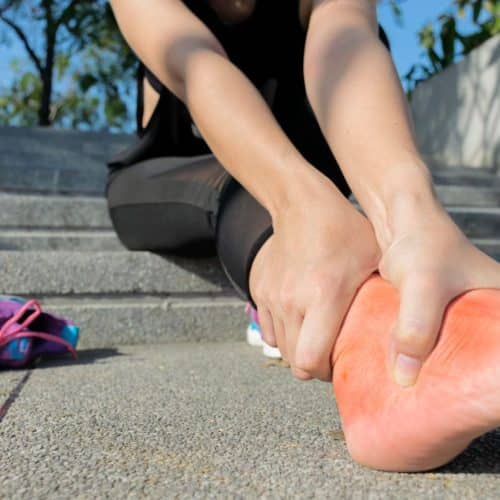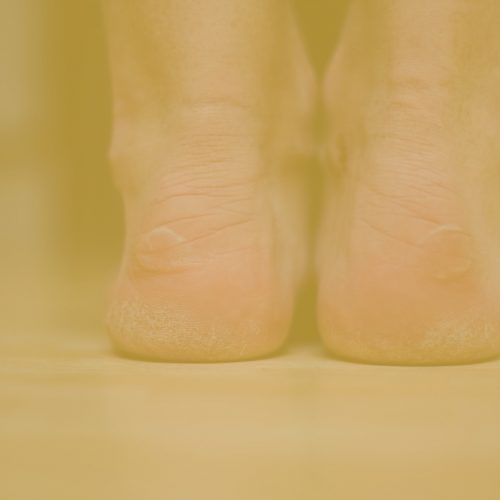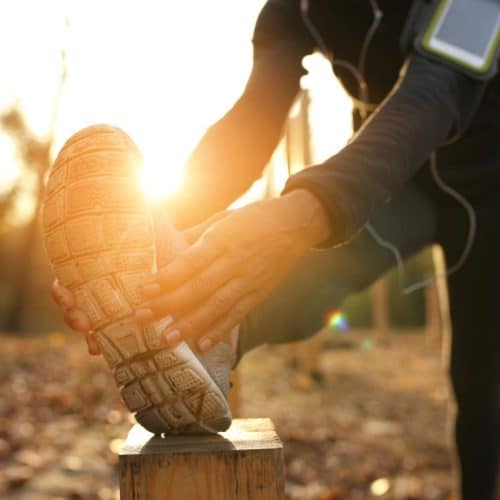Are you tired of starting your day with that sharp twinge in your heel? Waking up to morning foot pain can feel like a cruel way to begin. But worry not because relief might be simpler than you think. This article delves into effective heel pain exercises tailored specifically for morning plantar fasciitis discomfort. Say goodbye to those early morning hobble steps, and let’s explore how to step into your day with comfort and ease.
Understanding Plantar Fasciitis
Plantar fasciitis is a prevalent and often debilitating condition that affects the feet, particularly the heel area. To comprehend the complexities of this condition, it’s essential to delve into its causes, symptoms, and underlying mechanisms.
1. Causes and Risk Factors
Plantar fasciitis typically arises due to repetitive strain on the plantar fascia, a thick band of tissue that extends from the heel bone to the toes. This strain can result from various factors:
- Overuse: Engaging in activities that involve prolonged standing, walking, or running, especially on hard surfaces, can contribute to developing plantar fasciitis.
- Improper Footwear: Wearing shoes with inadequate arch support, cushioning, or shock absorption stresses the plantar fascia.
- Biomechanical Issues: High arches, flat feet, or abnormal gait patterns can alter weight distribution and impact how the plantar fascia absorbs and transmits shock.
- Age and Weight: Plantar fasciitis is more likely to occur in those in their middle years, who are overweight or obese, and who have a family history of the condition. This is because carrying around more weight places greater strain on the foot.
- Tight Muscles: Tight calf muscles or Achilles tendons can increase tension on the plantar fascia, contributing to inflammation.
- Occupation and Activities: Certain professions or sports that involve frequent jumping, running, or sudden changes in movement patterns can increase the risk.
2. Symptoms and Diagnosis
The hallmark symptom of plantar fasciitis is intense heel pain, especially with the first steps in the morning or after periods of inactivity. This pain often subsides as the foot warms up and becomes more flexible throughout the day. Other symptoms may include:
- Pain after Rest: Pain and stiffness can also occur after extended periods of sitting or resting.
- Sharp or Burning Sensation: Some individuals describe the pain as a sharp, stabbing sensation in the heel.
- Localised Discomfort: The pain is usually focused on the underside of the heel and may extend to the foot’s arch.
- Tenderness: Palpating the affected area might reveal tenderness and sensitivity.
- Limited Mobility: Severe cases may lead to limited mobility and difficulty bearing weight on the affected foot.
To diagnose plantar fasciitis, medical practitioners normally perform a comprehensive physical examination, enquire about the patient’s medical history, and evaluate the precise type of pain the patient is experiencing.
Imaging procedures such as X-rays or ultrasounds may be indicated in some instances to rule out other possible reasons for heel pain. These tests may be necessary in some circumstances.
3. Underlying Mechanisms
The plantar fascia supports the foot arch and absorbs shock during activities. Overuse or strain can lead to microtears in the fascia, triggering an inflammatory response. Combined with repeated stress, this inflammation causes the tissue to thicken and become less flexible.
Furthermore, the body’s healing response can lead to the formation of calcium deposits, further complicating the condition. The tightening of the plantar fascia during periods of inactivity, such as sleeping, often results in that characteristic sharp pain experienced during the first steps in the morning.
Understanding plantar fasciitis involves recognising its multifaceted origins, from lifestyle factors to biomechanical nuances. This understanding is crucial in guiding individuals towards effective preventive measures, appropriate treatment strategies, and a path to regaining pain-free mobility.
Benefits of Exercise for Heel Pain
Engaging in targeted exercises can be pivotal in managing and alleviating heel pain caused by plantar fasciitis. These exercises offer a range of benefits beyond mere pain relief, contributing to overall foot health and improved quality of life.
1. Pain Relief and Management
Regular exercise helps reduce the intensity and frequency of heel pain. The specific movements involved in these exercises stretch and strengthen the plantar fascia and surrounding muscles, promoting flexibility and enhancing the tissue’s ability to withstand stress. This, in turn, diminishes inflammation and decreases discomfort.
2. Strengthening the Affected Area
Exercises focusing on the plantar fascia and the muscles in the feet and calves contribute to enhanced muscle strength. A stronger support system for the arch of the foot translates to better shock absorption, reduced strain on the fascia, and improved weight distribution during movement.
3. Improved Blood Circulation
Physical activity encourages increased blood flow to the affected area. This surge in circulation promotes the delivery of essential nutrients and oxygen to the plantar fascia, aiding in the healing process. Additionally, improved circulation supports removing waste products that accumulate in inflamed tissues.
4. Enhanced Flexibility
Tightness in the calf muscles and Achilles tendons can exacerbate plantar fasciitis. Incorporating exercises that stretch these muscles enhances overall foot and ankle flexibility. Improved flexibility minimises tension on the plantar fascia, reducing strain and discomfort risk.
5. Prevention of Recurrence
Consistent exercise not only addresses current pain but also acts as a preventive measure against future occurrences of plantar fasciitis. Strengthening the plantar fascia and its surrounding muscles fortifies the foot’s structural integrity, making it more resilient to the stresses of daily activities.
6. Boosting Overall Foot Health
The benefits of exercise extend beyond the immediate area of pain. Engaging in foot-focused exercises can lead to increased proprioception (awareness of one’s body in space), improved balance, and reduced risk of other foot-related issues, such as arch collapse or overpronation.
7. Psychological Well-being
Chronic pain can take a toll on mental and emotional well-being. Engaging in exercises that bring relief offers physical comfort and a sense of empowerment and control over one’s condition. The release of endorphins during exercise can contribute to improved mood and reduced stress.
Various exercises targeting different muscle groups in the feet, calves, and ankles are essential for a comprehensive approach to managing heel pain. However, it’s crucial to start slowly, be consistent, and consult a podiatrist before beginning any exercise regimen, especially if the pain is severe or persistent.
Morning Heel Pain Exercises
Dealing with morning heel pain due to plantar fasciitis can be frustrating, but incorporating a targeted exercise routine into your daily regimen can make a significant difference. These exercises are designed to gently stretch and strengthen the affected area, helping you start your day with reduced pain and increased comfort.
1. Heel Stretching
Instructions: While still in bed, gently stretch your foot by flexing it upwards, aiming to point your toes towards your knee. Hold this position for 15-20 seconds, feeling a gentle pull along the back of your calf and under your foot. Repeat this stretch a few times before you get out of bed.
Benefits: Heel stretching is crucial for relieving the tightness in the plantar fascia and calf muscles that can build up during the night. It helps increase flexibility, reduce stiffness, and prepare your foot for weight-bearing activities.
2. Calf Raises
Instructions: Find a sturdy surface to hold onto, such as a countertop or chair’s back. Stand with your feet hip-width apart and slowly raise your heels off the ground, lifting yourself onto your toes. Hold this position for a moment before gently lowering your heels back down. Aim for 2-3 sets of 15 repetitions.
Benefits: Calf raises target the calf muscles and Achilles tendon, promoting strength and flexibility. Strong calves contribute to better shock absorption, reducing the strain on the plantar fascia.
3. Towel Scrunches
Instructions: Place a small towel on the floor in front of you. Use your toes to scrunch and gather the towel towards you as if you were picking it up with your foot. Release the towel and repeat the motion. Aim for 3 sets of 20 scrunches.
Benefits: This exercise engages the small muscles in your feet, enhancing their strength and dexterity. Strong foot muscles provide better support for the arch and help alleviate strain on the plantar fascia.
4. Ankle Alphabet
Instructions: Sit down with your leg extended in front of you. Using your big toe as a “pen,” “write” the alphabet in the air. Move your ankle through the entire range of motion, forming each letter with your foot. Perform this exercise for each foot.
Benefits: Ankle alphabet exercises improve ankle mobility and flexibility, reducing the risk of stiffness and discomfort during morning activities.
5. Toe Curls
Instructions: Place small objects, like marbles, on the floor. Use your toes to pick up the objects and place them in a container. Perform this exercise with both feet, aiming for 3 sets of 10-15 repetitions.
Benefits: Toe curls target the muscles that support the arch of your foot, contributing to its stability and strength. This exercise also enhances overall foot function.
Incorporating these exercises into your morning routine can help mitigate the discomfort of morning heel pain caused by plantar fasciitis. Remember, consistency is key – performing these exercises regularly can lead to improved flexibility, reduced pain, and a smoother start to your day.
Additional Tips for Alleviating Heel Pain
Dealing with heel pain caused by plantar fasciitis requires a comprehensive approach beyond exercises alone. Incorporating these additional tips into your daily routine can further enhance your efforts to alleviate discomfort and promote healing.
1. Proper Footwear
Choosing the right footwear is essential for managing plantar fasciitis. Opt for shoes that provide adequate arch support, cushioning, and shock absorption. Look for models designed specifically for comfort and foot health. Avoid shoes with flat soles or inadequate support, as they can exacerbate heel pain.
2. Ice Massage
Applying cold therapy through ice massage can help reduce inflammation and soothe pain initially. Roll a frozen water bottle under your foot, focusing on the area causing the most discomfort. Perform this massage for 10-15 minutes daily, particularly after exercises or activities that may trigger pain. However if your heel pain is chronic it is best to use heat to increase circulation and healing to the area.
3. Night Splints
Wearing night splints can be beneficial, especially if you experience intense morning pain. These devices help keep your foot flexed while you sleep, preventing the plantar fascia from tightening excessively overnight. Night splints promote gradual stretching and reduce discomfort during those early steps in the morning.
4. Rest and Recovery
Balancing physical activity with proper rest is crucial. Avoid overexerting yourself and give your feet time to recover between exercises or activities. Adequate rest allows the inflamed tissues to heal and reduces the risk of exacerbating the condition.
5. Arch Support Inserts
Consider using arch support inserts or orthotic insoles to provide additional cushioning and support for your feet. These inserts can help distribute pressure more evenly across the foot, reducing strain on the plantar fascia and promoting better alignment.
6. Elevate Your Feet
Elevating your feet whenever possible can help reduce swelling and improve blood circulation. Prop up your feet on a cushion or pillow when sitting or lying down. This simple practice can aid in reducing discomfort and promoting healing.
7. Maintain a Healthy Weight
Excess body weight can contribute to increased strain on the plantar fascia. Maintaining a healthy weight through a balanced diet and regular exercise can help alleviate pressure on your feet and reduce the risk of flare-ups.
8. Stretch Before Activities
Before beginning any type of physical exercise, whether it’s a severe workout or simply a routine stroll, it’s important to warm up your calf muscles and plantar fascia by performing certain stretches. Stretching helps your muscles and tissues get ready for action, which minimises the likelihood that you may have a sudden strain due to the exercise.
9. Stay Hydrated
Adequate hydration supports overall tissue health, including the plantar fascia. Drink plenty of water throughout the day to ensure your body remains hydrated.
10. Listen to Your Body
Pay attention to your body’s signals. If an exercise or activity exacerbates your pain, stop and rest. It’s important to push yourself gradually and avoid activities that cause excessive discomfort.
Footwear and Support
Selecting the right footwear and providing adequate foot support are integral to managing and preventing heel pain associated with plantar fasciitis. Your shoes are pivotal in maintaining proper alignment, cushioning, and overall foot health.
1. Choosing the Right Shoes
Investing in shoes that prioritise comfort and support is essential. When shopping for footwear to alleviate plantar fasciitis-related pain, consider the following factors:
- Arch Support: Look for shoes with built-in arch support that matches the natural curve of your foot. Proper arch support helps distribute weight evenly and reduces strain on the plantar fascia.
- Cushioning: Opt for shoes with adequate cushioning, especially in the heel and arch areas. Cushioned shoes absorb impact and provide relief during daily activities.
- Heel Stability: Shoes with a firm heel counter (the back part of the shoe) offer better stability, minimising unnecessary movement and strain on the plantar fascia.
- Toe Box Space: Choose shoes with a roomy toe box to allow your toes to move freely. This prevents crowding and potential discomfort.
- Flexible Soles: Shoes with flexible soles facilitate natural foot movement and reduce strain on the plantar fascia during walking and other activities.
2. Orthotic Inserts
Orthotic inserts or insoles are additional cushioned supports that can be inserted into your shoes. These inserts are designed to provide customised arch support and cushioning tailored to your foot’s needs. Off-the-shelf or custom-made orthotics can help improve foot alignment, reduce strain, and promote better shock absorption.
3. Heel Cups and Pads
Heel cups and pads are specialised inserts providing extra cushioning and heel area support. They help reduce impact during walking and relieve the plantar fascia by absorbing some of the forces contributing to pain.
4. Avoid High Heels and Flat Shoes
High-heeled shoes and flat shoes, such a ballet flats with inadequate support can worsen plantar fasciitis symptoms. High heels alter the foot’s natural alignment and increase pressure on the forefoot, while flat shoes lack the arch support needed to reduce strain on the plantar fascia.
5. Footwear for Different Activities
Consider the type of activity you’ll be engaging in when selecting footwear. Athletic shoes designed for walking, running, or other sports should have the appropriate features to support your feet during those activities. If you spend long hours standing, prioritise comfort and support with cushioned and supportive shoes.
6. Regular Shoe Assessment
As time goes on, the cushioning and support of shoes can deteriorate. Regularly evaluate your shoes for signs of wear and tear, such as flattened cushioning or uneven tread. Replace worn-out shoes promptly to ensure you receive the optimal support for managing plantar fasciitis.
Remember, the shoes you choose impact your foot health and overall well-being. Prioritise comfort and support, and consider consulting with a podiatrist or orthopedic specialist to receive personalised recommendations based on your unique foot structure and needs.
When to Seek Professional Help
While exercises and home remedies can often provide relief for mild cases of plantar fasciitis, there are situations where professional medical assistance is necessary. Knowing when to seek help from a podiatrist is crucial to ensure proper diagnosis, treatment, and prevention of further complications.
1. Persistent or Intense Pain
If your heel pain persists despite diligent adherence to exercises and self-care measures, it’s time to consult a podiatrist. Intense or worsening pain, especially after several weeks of conservative treatment, requires a medical evaluation to identify underlying issues.
2. Limited Mobility
Suppose your heel pain is causing significant limitations in your ability to walk, stand, or engage in regular activities. In that case, it indicates that professional help is needed. Limited mobility can impact your overall quality of life, and a podiatrist can offer tailored solutions.
3. No Improvement with Rest
If resting and avoiding activities that trigger pain haven’t improved, it’s a sign that the condition may be more complex than initially thought. A podiatrist can perform a thorough assessment and recommend appropriate interventions.
4. Signs of Infection
In rare cases, plantar fasciitis can lead to complications such as infections. If you notice redness, swelling, warmth, or pus around the affected heel, seek medical attention promptly. These signs could indicate an infection that requires medical treatment.
5. Other Underlying Conditions
If you have underlying medical conditions such as diabetes or arthritis, it’s essential to consult a healthcare professional early on. These conditions can complicate the management of plantar fasciitis and require specialised care.
6. Professional Diagnosis and Treatment
An orthopaedic specialist or a podiatrist may provide you with a complete diagnosis by reviewing your medical history, performing a physical exam, and, if necessary, ordering imaging tests such as X-rays or ultrasounds. This can help the practitioner determine what is wrong with you. They have a high degree of success distinguishing plantar fasciitis from the myriad of other conditions that could contribute to heel discomfort.
7. Customised Treatment Plans
A professional will tailor a treatment plan to your specific condition and needs. This might include advanced therapies such as physical therapy, corticosteroid injections to reduce inflammation, custom orthotics for better foot support, or even extracorporeal shockwave therapy in severe cases.
8. Prevention and Long-Term Management
Podiatrists provide valuable insights into preventing future flare-ups. They can guide you on proper footwear choices, recommend exercises that suit your condition, and offer strategies to incorporate foot care into your daily routine.
9. Surgical Intervention
In rare instances where conservative treatments fail, surgery might be considered. A podiatrist can discuss surgical options’ benefits, risks, and potential outcomes, ensuring you make an informed decision.
Remember, seeking professional help sooner rather than later can lead to faster relief and prevent the progression of plantar fasciitis. Your podiatrist is your partner in managing your heel pain and ensuring your feet’s long-term health.
Conclusion
Incorporating morning exercises into your routine to combat heel pain caused by plantar fasciitis can significantly improve your overall well-being. You can gradually alleviate discomfort and enhance your mobility by targeting the inflamed tissue connecting your heel bone to your toes. Remember, consistency is key in exercises designed to address this common ailment.
Stretching and strengthening exercises and proper footwear and rest can contribute to a noticeable reduction in morning heel pain. Consult your podiatrist or a physical therapist before starting any new exercise regimen, especially if you’re dealing with severe pain or pre-existing conditions.
How will you integrate these exercises into your morning routine to ensure consistent progress in overcoming plantar fasciitis?
Leave your thoughts in the comments section below and share your strategies for staying committed to your exercise routine. Together, let’s conquer morning heel pain and become more comfortable and active!
Content Summary
- Waking up to morning foot pain can feel like a cruel way to begin.
- Say goodbye to those early morning hobble steps, and let’s explore how to step into your day with comfort and ease.
- When battling morning plantar fasciitis, these exercises can be your saving grace.
- By incorporating a targeted routine into your daily regimen, you can experience noticeable improvements.
- From gentle calf stretches that soothe the tension in your arch to toe scrunches that awaken and strengthen your feet, this article unveils a set of exercises designed to alleviate morning heel pain.
- Plantar fasciitis is a prevalent and often debilitating condition that affects the feet, particularly the heel area.
- The hallmark symptom of plantar fasciitis is intense heel pain, especially with the first steps in the morning or after periods of inactivity.
- The plantar fascia supports the foot arch and absorbs shock during activities.
- Regular exercise helps reduce the intensity and frequency of heel pain.
- Exercises that focus on the plantar fascia and the muscles in the feet and calves contribute to enhanced muscle strength.
- Incorporating exercises that stretch these muscles enhances overall foot and ankle flexibility.
- Consistent exercise not only addresses current pain but also acts as a preventive measure against future occurrences of plantar fasciitis.
- The benefits of exercise extend beyond the immediate area of pain.
- Engaging in foot-focused exercises can lead to increased proprioception (awareness of one’s body in space), improved balance, and reduced risk of other foot-related issues, such as arch collapse or overpronation.
- Chronic pain can take a toll on mental and emotional well-being.
- Engaging in exercises that bring relief offers physical comfort and a sense of empowerment and control over one’s condition.
- Dealing with morning heel pain due to plantar fasciitis can be frustrating, but incorporating a targeted exercise routine into your daily regimen can make a significant difference.
- These exercises are designed to gently stretch and strengthen the affected area, helping you start your day with reduced pain and increased comfort.
- Sit down with your leg extended in front of you.
- Toe curls target the muscles that support the arch of your foot, contributing to its stability and strength.
- Incorporating these exercises into your morning routine can help mitigate the discomfort of morning heel pain caused by plantar fasciitis.
- Dealing with heel pain caused by plantar fasciitis requires a comprehensive approach beyond exercises alone.
- Incorporating these additional tips into your daily routine can further enhance your efforts to alleviate discomfort and promote healing.
- Choosing the right footwear is essential for managing plantar fasciitis.
- Applying cold therapy through ice massage can help reduce inflammation and soothe pain.
- Balancing physical activity with proper rest is crucial.
- Prop up your feet on a cushion or pillow when sitting or lying down.
- Excess body weight can contribute to increased strain on the plantar fascia.
- Maintaining a healthy weight through a balanced diet and regular exercise can help alleviate pressure on your feet and reduce the risk of flare-ups.
- Drink plenty of water throughout the day to ensure your body remains hydrated.
- Selecting the right footwear and providing adequate foot support are integral to managing and preventing heel pain associated with plantar fasciitis.
- Investing in shoes that prioritise comfort and support is essential.
- Orthotic inserts or insoles are additional cushioned supports that can be inserted into your shoes.
- Off-the-shelf or custom-made orthotics can help improve foot alignment, reduce strain, and promote better shock absorption.
- High-heeled shoes and flat shoes with inadequate support can worsen plantar fasciitis symptoms.
- Consider the type of activity you’ll be engaging in when selecting footwear.
- If you spend long hours standing, prioritise comfort and support with cushioned and supportive shoes.
- Remember, the shoes you choose impact your foot health and overall well-being.
- Prioritise comfort and support, and consider consulting with a podiatrist or orthopedic specialist to receive personalised recommendations based on your unique foot structure and needs.
- While exercises and home remedies can often provide relief for mild cases of plantar fasciitis, there are situations where professional medical assistance is necessary.
- Knowing when to seek help from a podiatrist is crucial to ensure proper diagnosis, treatment, and prevention of further complications.
- Suppose your heel pain is causing significant limitations in your ability to walk, stand, or engage in regular activities.
- In that case, it indicates that professional help is needed.
- Limited mobility can impact your overall quality of life, and a podiatrist can offer tailored solutions.
- A podiatrist can perform a thorough assessment and recommend appropriate interventions.
- In rare cases, plantar fasciitis can lead to complications such as infections.
- If you notice redness, swelling, warmth, or pus around the affected heel, seek medical attention promptly.
- These signs could indicate an infection that requires medical treatment.
- If you have underlying medical conditions such as diabetes or arthritis, it’s essential to consult a healthcare professional early on.
- These conditions can complicate the management of plantar fasciitis and require specialised care.
- An orthopaedic specialist or a podiatrist may provide you with a complete diagnosis by reviewing your medical history, performing a physical exam, and, if necessary, ordering imaging tests such as X-rays or ultrasounds.
- They have a high degree of success distinguishing plantar fasciitis from the myriad of other conditions that could contribute to heel discomfort.
- A professional will tailor a treatment plan to your specific condition and needs.
- Podiatrists provide valuable insights into preventing future flare-ups.
- They can guide you on proper footwear choices, recommend exercises that suit your condition, and offer strategies to incorporate foot care into your daily routine.
- Your podiatrist is your partner in managing your heel pain and ensuring your feet’s long-term health.
- Incorporating morning exercises into your routine to combat heel pain caused by plantar fasciitis can significantly improve your overall well-being.
- Stretching and strengthening exercises and proper footwear and rest can significantly reduce morning heel pain.
- Consult your podiatrist or a physical therapist before starting any new exercise regimen, especially if you’re dealing with severe pain or pre-existing conditions.
FAQs
1. Can I do these exercises throughout the day?
Absolutely! Incorporating these exercises into your daily routine can promote healing and prevent pain.
2. How long does it take to see results?
Results vary, but with consistent effort, many individuals experience improvement within a few weeks.
3. Can overweight individuals get plantar fasciitis more often?
People who are overweight have an increased risk of developing plantar fasciitis because the pressure that is exerted on their plantar fascia is amplified when they are overweight. Plantar fasciitis is characterised by a pain that radiates from the heel to the ball of the foot.
4. Are there any preventive measures for plantar fasciitis?
Maintaining a healthy weight, wearing proper footwear, and avoiding sudden increases in physical activity can help prevent it.
5. Are both feet usually affected?
Plantar fasciitis can affect one or both feet, but it’s common for it to occur in both if not treated promptly.


